Related Research Articles

Chapel Hill is a town in Orange and Durham counties in the U.S. state of North Carolina. Its population was 61,960 in the 2020 census, making Chapel Hill the 17th-most populous municipality in the state. Chapel Hill and Durham make up the Durham-Chapel Hill, NC Metropolitan Statistical Area, which had an estimated population of 608,879 in 2023. When it's combined with Raleigh, the state capital, they make up the corners of the Research Triangle, which had an estimated population of 2,368,947 in 2023.

The University of North Carolina at Chapel Hill is a public research university in Chapel Hill, North Carolina. Chartered in 1789, the university first began enrolling students in 1795, making it one of the oldest public universities in the United States.

Orange County is a county located in the Piedmont region of the U.S. state of North Carolina. As of the 2020 census, the population was 148,696. Its county seat is Hillsborough.
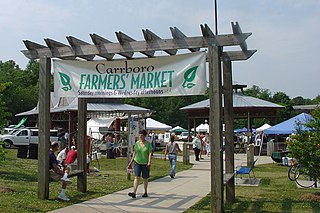
Carrboro is a town in Orange County in the U.S. state of North Carolina. The population was 21,295 at the 2020 census. The town, which is part of the Raleigh-Durham-Chapel Hill combined statistical area, was named after North Carolina industrialist Julian Shakespeare Carr.
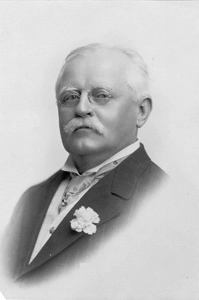
Julian Shakespeare Carr was an American industrialist, philanthropist, and white supremacist. He is the namesake of the town of Carrboro, North Carolina.
The William Lanier Hunt Arboretum is an arboretum and natural area that forms part of the North Carolina Botanical Garden. It is operated by the University of North Carolina at Chapel Hill, Old Mason Farm Road, Chapel Hill, North Carolina. The arboretum is private and not open to the public. Arboretum property was donated by William Lanier Hunt between the 1960s and the 1990s in order to protect natural areas and conserve woody plants of the southeastern United States. It includes several rhododendron bluffs in a gorge along Morgan Creek.

Southern Village is a 312-acre (1.3 km2) New Urbanism neighborhood located in Chapel Hill, North Carolina. Established in 1994, Southern Village includes 550 single-family homes, 375 townhomes and condominiums, 250 apartments, and 350,000 square feet (33,000 m2) of retail, office, and civic space. Southern Village was the top selling neighborhood in the Triangle market from 1999 to 2001. Nationally recognized as an example of smart growth, Southern Village has been featured in numerous publications including TIME, Better Homes & Gardens, and Builder magazines.

Chapel Hill Transit operates public bus and van transportation services within the contiguous municipalities of Chapel Hill and Carrboro and the campus of the University of North Carolina at Chapel Hill in the southeast corner of Orange County in the Research Triangle metropolitan region of North Carolina. Chapel Hill Transit operates its fixed route system fare free due to a contractual agreement with the two towns and the university to share annual operating and capital costs. In 2023, the system had a ridership of 3,855,400, or about 16,600 per weekday as of the fourth quarter of 2023.

Carr Mill Mall is a small, local shopping mall located in Carrboro, North Carolina. It is listed on the National Register of Historic Places as the Alberta Mill Complex. It is also a host for numerous local live performances and other cultural events.

The State University Railroad is a 10.2 mile railroad spur of the North Carolina Railroad that began offering service from Glenn, North Carolina, near Hillsborough to a point west of Chapel Hill, North Carolina on January 1, 1882.

Weaver Street Market is a worker- and consumer-owned cooperative selling natural and organic food with a focus on local and fair trade products. The original market is situated in the heart of Carrboro, North Carolina in Carr Mill Mall and plays host to many community events. It occupies a central location in the town of Carrboro and serves as a "community gathering place."

Franklin Street is a prominent thoroughfare in Chapel Hill, North Carolina. Historic Franklin Street is considered the center of social life for the University of North Carolina at Chapel Hill, as well as the town of Chapel Hill.
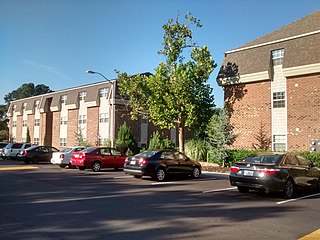
Formerly Abby Court, and previously Old Well, is a complex of over 300 residences in North Carolina.
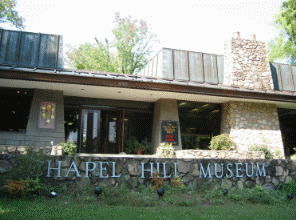
Chapel Hill Museum was a local cultural and historical museum in Chapel Hill, North Carolina. The museum was founded in 1996 by leaders of the Town of Chapel Hill's Bicentennial Committee and celebrated its 10th anniversary in 2006. In the decade since its founding, Chapel Hill Museum averaged over 20,000 visitors a year and provided education programs to over 3,500 local students a year. The museum closed on July 11, 2010.
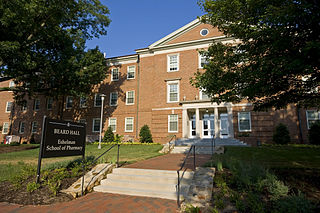
The UNC Eshelman School of Pharmacy is located at the University of North Carolina at Chapel Hill, and includes a satellite campus at UNC Asheville. The Asheville School of Pharmacy campus opened in 2011, and graduated its first class in 2015.

Top of the Hill (TOPO) is a brewpub, restaurant, event space and distillery located in downtown Chapel Hill, North Carolina. The restaurant and brewery opened in 1994 at the intersection of Franklin and Columbia Streets adjacent to the University of North Carolina at Chapel Hill. It was one of the first microbreweries in the state. TOPO expanded in 2010, adding the Great Room event space and the Back Bar, which is home to North Carolina's first on-premise cask ale program.

CHYDARU, unabbreviated name Chapel Hill Youth Development and Research Unit, was an experimental youth prison operated by the Institute of Government at the University of North Carolina at Chapel Hill and the North Carolina prison system. Built in 1945, it opened as a prison for youth under the age of 18 on May 1, 1964. The project was as an advancement in prison structure. It closed later in 1965 due to budget shortages. Sometime during the 1970s it housed the Bureau of School Services, which was operated by UNC. Later in 1975, it was repurposed to store radioactive waste. As of 1996, it became exclusively a radioactive storage-for-decay facility, where short-lived radioactive wastes are stored until they are no longer radioactive, at which point they are removed. It is inspected annually by the state government.
Morgan Creek is a 21.03 mi (33.84 km) long 4th order tributary to the New Hope River in North Carolina. Morgan Creek forms the New Hope River along with New Hope Creek within the B. Everett Jordan Lake Reservoir.
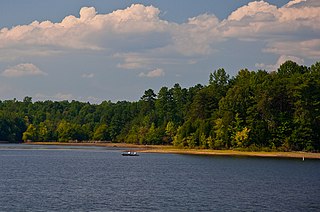
Cane Creek Reservoir is a reservoir in Orange County, North Carolina serving the Carrboro-Chapel Hill area. It is operated by the Orange Water and Sewer Authority (OWASA).
The Orange Water and Sewer Authority is a nonprofit public utility that provides water and sewage services to the Carrboro-Chapel Hill area. It gets its water from Cane Creek Reservoir, University Lake, and Stone Quarry Reservoir. OWASA has 343 miles of water mains and 294 miles of sewers. Its water is treated at the Jones Ferry Road Water Treatment Plant.
References
- ↑ "University Lake".
- ↑ "University Lake". Geographic Names Information System . United States Geological Survey, United States Department of the Interior . Retrieved April 5, 2024.
- ↑ Odum, Eugene; Taylor, Edmund; Coker, Coit; Breckenridge, Arnold (1935). "The Birds of Chapel Hill, North Carolina". Journal of the Elisha Mitchell Scientific Society. 51 (2): 312–340. ISSN 0013-6220. JSTOR 24332868.
- 1 2 3 "University Lake · Water at UNC-Chapel Hill · Carolina Story: Virtual Museum of University History". museum.unc.edu. Retrieved 2024-03-30.
- ↑ Cane Creek Water Supply Reservoir Permit: Environmental Impact Statement. 1981. p. 50.
- ↑ Day Trips from Raleigh-Durham: Getaway Ideas for the Local Traveler. Rowman & Littlefield. p. 118. ISBN 978-0-7627-5210-2.
- ↑ Madry, Sarah Brandes (March 2004). Well Worth a Shindy: The Architectural and Philosophical History of the Old Well at the University of North Carolina at Chapel Hill. iUniverse. p. 45. ISBN 978-0-595-30057-0.
- ↑ "Impact of Safe Drinking Water Act Amendments of 1986 on Selected Utilities in NOrth Carolina".
- ↑ "University Lake". www.visitchapelhill.org. Retrieved 2024-03-30.
35°53′47″N79°05′39″W / 35.89639°N 79.09417°W